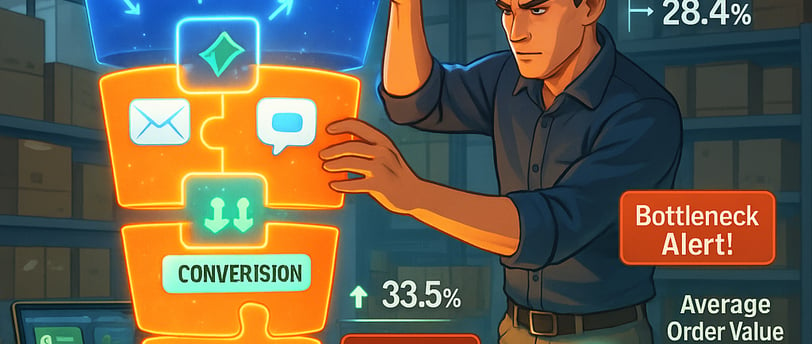How to Build a High-Converting Sales Funnel for Your E-commerce Business
Discover the step-by-step process to create a sales funnel that drives conversions and maximizes revenue for your e-commerce business. Learn how to attract, engage, and convert your audience into loyal customers.
MARKETING AUTOMATION
6/2/20253 min read


Introduction
In the fast-paced world of e-commerce, having a well-structured sales funnel is no longer optional—it’s a necessity. A sales funnel is the journey your customers take from discovering your brand to making a purchase and beyond. When optimized correctly, it can significantly boost your conversion rates, increase customer lifetime value, and drive sustainable growth.
But how do you build a sales funnel that actually converts? In this guide, we’ll walk you through the essential steps to create a high-converting sales funnel tailored to your e-commerce business.
What is a Sales Funnel?
A sales funnel is a visual representation of the customer journey, divided into stages that guide potential buyers toward making a purchase. The funnel narrows at each stage, as not all visitors will convert into customers. The key stages of a sales funnel are:
Awareness: The customer becomes aware of your brand or product.
Interest: The customer shows interest in what you offer.
Decision: The customer considers purchasing your product.
Action: The customer completes the purchase.
Retention: The customer becomes a repeat buyer or brand advocate.
Understanding these stages is crucial for optimizing your funnel and maximizing conversions.
Step 1: Attract Your Target Audience (Awareness Stage)
The first step in building a sales funnel is attracting the right audience. Without traffic, there’s no one to convert. Here’s how to do it:
SEO Optimization: Use keyword research to create content that ranks high on search engines. Focus on long-tail keywords that match your audience’s search intent.
Social Media Marketing: Leverage platforms like Instagram, Facebook, and TikTok to showcase your products and engage with your audience.
Paid Advertising: Use Google Ads, Facebook Ads, or retargeting campaigns to drive targeted traffic to your website.
Content Marketing: Publish blogs, videos, and infographics that address your audience’s pain points and provide value.
Pro Tip: Use analytics tools like Google Analytics to track which channels bring the most traffic and focus your efforts there.
Step 2: Engage and Nurture Leads (Interest Stage)
Once you’ve attracted visitors, the next step is to engage them and nurture their interest. This is where you build trust and establish your brand as a solution to their problems.
Lead Magnets: Offer free resources like eBooks, discounts, or free trials in exchange for their email addresses.
Email Marketing: Send personalized emails that provide value, such as product recommendations, how-to guides, or exclusive offers.
Retargeting Ads: Use retargeting campaigns to remind visitors about your products and bring them back to your site.
Live Chat: Implement live chat support to answer questions and address concerns in real-time.
Pro Tip: Segment your email list based on user behavior to send more targeted and relevant messages.
Step 3: Convert Leads into Customers (Decision Stage)
At this stage, your leads are considering a purchase. Your goal is to make the decision-making process as easy and compelling as possible.
Product Pages: Ensure your product pages are detailed, visually appealing, and include high-quality images, videos, and customer reviews.
Trust Signals: Display security badges, testimonials, and guarantees to build trust and reduce hesitation.
Urgency and Scarcity: Use tactics like limited-time offers or low-stock alerts to encourage immediate action.
Multiple Payment Options: Offer a variety of payment methods, including credit cards, PayPal, and buy-now-pay-later options.
Pro Tip: Use A/B testing to optimize your product pages and CTAs for maximum conversions.
Step 4: Simplify the Checkout Process (Action Stage)
A complicated checkout process is one of the biggest reasons for cart abandonment. Here’s how to make it seamless:
Guest Checkout: Allow customers to check out without creating an account.
One-Page Checkout: Reduce the number of steps required to complete a purchase.
Autofill Forms: Use autofill to make it easier for customers to enter their information.
Free Shipping: Offer free shipping or clearly display shipping costs upfront to avoid surprises.
Pro Tip: Use exit-intent popups to offer discounts or incentives to customers who are about to leave without purchasing.
Step 5: Retain and Upsell Customers (Retention Stage)
The journey doesn’t end after the first purchase. Retaining customers and turning them into repeat buyers is key to long-term success.
Post-Purchase Emails: Send thank-you emails, request reviews, and provide order updates.
Loyalty Programs: Reward repeat customers with points, discounts, or exclusive perks.
Upsell and Cross-Sell: Recommend complementary products or upgrades based on their purchase history.
Personalized Offers: Use customer data to send personalized offers and recommendations.
Pro Tip: Use CRM tools to track customer behavior and create personalized retention strategies.
Conclusion
Building a high-converting sales funnel is not a one-time task—it’s an ongoing process that requires constant optimization and testing. By understanding your audience, addressing their needs at every stage, and leveraging data-driven insights, you can create a sales funnel that drives consistent results and grows your e-commerce business.
Start implementing these strategies today, and watch your conversions soar!
